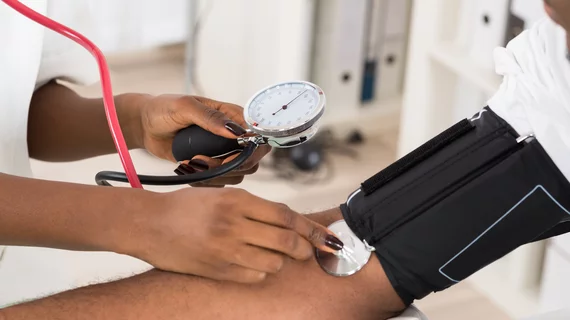Weight gain puts collegiate athletes at risk of CVD
Elite athletes are at a decreased risk of death from cardiovascular problems, but one subgroup actually faces greater risk of cardiovascular disease. That subgroup is U.S. collegiate football players, who typically gain weight during early training and, in turn, develop increased systolic blood pressure levels, according to a study published in JAMA Cardiology on Oct. 16.
To address the emergence and progression of multiple individual factors associated with cardiovascular risk across consecutive years of college-level football play, researchers recruited collegiate U.S. football athletes from two NCAA Division I programs. Recruitment occurred between June 2014 and June 2017, when the subjects were in their freshman year of college. Subjects were then analyzed at multiple points throughout three complete years of collegiate football participation, until January 2019.
Transthoracic echocardiography and vascular applanation tonometry were used to assess factors associated with clinical risk. “Exposure of interest was seasonal U.S. football exposure, including training, competition, and the training environment," wrote lead author Jonathan H. Kim, MD, MSc, of the Division of Cardiology, Emory Cardiovascular Research Institute, Atlanta, and colleagues.
Primary outcome measures investigated included left ventricular mass index and geometry (cardiac structure), early diastolic myocardial relaxation velocity (E’; diastolic function), and pulse-wave velocity (arterial stiffness). Data from 126 of the 186 individuals who had originally been recruited were analyzed; the remaining 60 players were excluded from the study because they had not completed any given season of training due to injury, illness, or withdrawal from their team.
The study subjects weighed a mean (SD) of 101.1 (21.0) kg and had a mean systolic blood pressure of 129.1 (11.6) mm Hg at baseline of the freshman season. Adjusting for race, height, and player position, the researchers noted “significant” increases in weight, systolic blood pressure, and pulse-wave velocity among subjects across three years of collegiate football participation. They also found significant declines in E’.
Weight gain was associated with both arterial stiffening (increased pulse-wave velocity) and the development of concentric left ventricular hypertrophy. The researchers also noted a correlation between increased systolic blood pressure and arterial stiffening, along with an association between increased systolic blood pressure and concentric left ventricular hypertrophy.
“Collegiate U.S. athletes who gain weight and develop increased systolic blood pressure levels are at risk for the development of a pathologic CV phenotype characterized by concentric left ventricular hypertrophy, arterial stiffening, and reduced left ventricular diastolic function,” the study authors concluded. “Future work aimed at optimizing cardiovascular health in this population, who are young but uniquely at risk, is warranted.”
